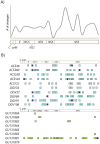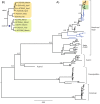Inter- and intra-host viral diversity in a large seasonal DENV2 outbreak
- PMID: 23936406
- PMCID: PMC3732279
- DOI: 10.1371/journal.pone.0070318
Inter- and intra-host viral diversity in a large seasonal DENV2 outbreak
Abstract
Background: High genetic diversity at both inter- and intra-host level are hallmarks of RNA viruses due to the error-prone nature of their genome replication. Several groups have evaluated the extent of viral variability using different RNA virus deep sequencing methods. Although much of this effort has been dedicated to pathogens that cause chronic infections in humans, few studies investigated arthropod-borne, acute viral infections.
Methods and principal findings: We deep sequenced the complete genome of ten DENV2 isolates from representative classical and severe cases sampled in a large outbreak in Brazil using two different approaches. Analysis of the consensus genomes confirmed the larger extent of the 2010 epidemic in comparison to a previous epidemic caused by the same viruses in another city two years before (genetic distance = 0.002 and 0.0008 respectively). Analysis of viral populations within the host revealed a high level of conservation. After excluding homopolymer regions of 454/Roche generated sequences, we found 10 to 44 variable sites per genome population at a frequency of >1%, resulting in very low intra-host genetic diversity. While up to 60% of all variable sites at intra-host level were non-synonymous changes, only 10% of inter-host variability resulted from non-synonymous mutations, indicative of purifying selection at the population level.
Conclusions and significance: Despite the error-prone nature of RNA-dependent RNA-polymerase, dengue viruses maintain low levels of intra-host variability.
Conflict of interest statement
Figures



Similar articles
-
Increasing Clinical Severity during a Dengue Virus Type 3 Cuban Epidemic: Deep Sequencing of Evolving Viral Populations.J Virol. 2016 Apr 14;90(9):4320-4333. doi: 10.1128/JVI.02647-15. Print 2016 May. J Virol. 2016. PMID: 26889031 Free PMC article.
-
Inter- and intra-host sequence diversity reveal the emergence of viral variants during an overwintering epidemic caused by dengue virus serotype 2 in southern Taiwan.PLoS Negl Trop Dis. 2018 Oct 4;12(10):e0006827. doi: 10.1371/journal.pntd.0006827. eCollection 2018 Oct. PLoS Negl Trop Dis. 2018. PMID: 30286095 Free PMC article.
-
Genetic Drift, Purifying Selection and Vector Genotype Shape Dengue Virus Intra-host Genetic Diversity in Mosquitoes.PLoS Genet. 2016 Jun 15;12(6):e1006111. doi: 10.1371/journal.pgen.1006111. eCollection 2016 Jun. PLoS Genet. 2016. PMID: 27304978 Free PMC article.
-
Effect of low-passage number on dengue consensus genomes and intra-host variant frequencies.J Gen Virol. 2021 Mar;102(3):001553. doi: 10.1099/jgv.0.001553. Epub 2021 Feb 16. J Gen Virol. 2021. PMID: 33591246 Free PMC article.
-
Within-Host Viral Diversity: A Window into Viral Evolution.Annu Rev Virol. 2020 Sep 29;7(1):63-81. doi: 10.1146/annurev-virology-010320-061642. Epub 2020 Jun 8. Annu Rev Virol. 2020. PMID: 32511081 Free PMC article. Review.
Cited by
-
Detection of coinfection with Primate Erythroparvovirus 1 and arboviruses (DENV, CHIKV and ZIKV) in individuals with acute febrile illness in the state of Rio Grande do Norte in 2016.PLoS Negl Trop Dis. 2023 Nov 2;17(11):e0011701. doi: 10.1371/journal.pntd.0011701. eCollection 2023 Nov. PLoS Negl Trop Dis. 2023. PMID: 37917659 Free PMC article.
-
West Nile Virus Population Structure, Injury, and Interferon-Stimulated Gene Expression in the Brain From a Fatal Case of Encephalitis.Open Forum Infect Dis. 2015 Nov 20;3(1):ofv182. doi: 10.1093/ofid/ofv182. eCollection 2016 Jan. Open Forum Infect Dis. 2015. PMID: 26730392 Free PMC article.
-
Contribution of phylogenetics to understanding the evolution and epidemiology of dengue virus.Animal Model Exp Med. 2022 Oct;5(5):410-417. doi: 10.1002/ame2.12283. Epub 2022 Oct 17. Animal Model Exp Med. 2022. PMID: 36245335 Free PMC article. Review.
-
Endless Forms: Within-Host Variation in the Structure of the West Nile Virus RNA Genome during Serial Passage in Bird Hosts.mSphere. 2019 Jun 26;4(3):e00291-19. doi: 10.1128/mSphere.00291-19. mSphere. 2019. PMID: 31243074 Free PMC article.
-
Increasing Clinical Severity during a Dengue Virus Type 3 Cuban Epidemic: Deep Sequencing of Evolving Viral Populations.J Virol. 2016 Apr 14;90(9):4320-4333. doi: 10.1128/JVI.02647-15. Print 2016 May. J Virol. 2016. PMID: 26889031 Free PMC article.
References
-
- PAHO (2008) Number of Reported Cases of Dengue and Dengue Hemorrhagic Fever (DHF), Region of the Americas (by country and subregion). Pan American Health Society.
-
- CVE DdZ (2010) São Paulo. pp. Dados Provisórios do CVE- dengue.
-
- Grenfell B, Pybus O, Gog J, Wood J, Daly J, et al. (2004) Unifying the epidemiological and evolutionary dynamics of pathogens. Science 303: 327–332. - PubMed
Publication types
MeSH terms
Substances
Grants and funding
LinkOut - more resources
Full Text Sources
Other Literature Sources
Medical
Molecular Biology Databases

